Wasp Waists and Stuffed Shirts
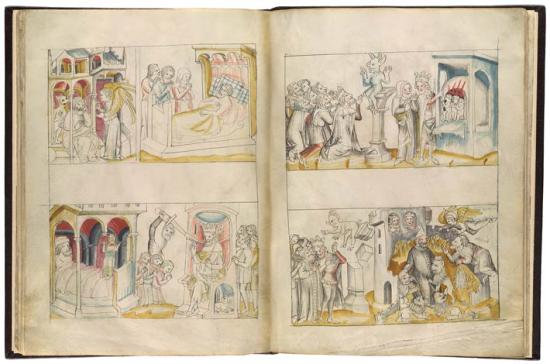
History Bible, in Latin and German
Purchased by Pierpont Morgan, 1907
Alexander the Great Fashionista
Alexander the Great, especially in the scenes at the lower right, exhibits the wasp waist and bulbous torso that characterize the fashionable look for men during the second half of the fourteenth century. Buttons and padding in the doublet's chest and shoulders helped achieve this hourglass silhouette. A low-slung "Bohemian" girdle and pouleines (pointed shoes) complete the look. The women in these vignettes, including Candace (to whom the king makes love), are depicted with similar silhouettes. The woman's distinctively frilly ruffled hood is particular to Germany and parts of the Netherlands but not France.
Wasp Waists and Stuffed Shirts
The second half of the fourteenth century was a bleak period in French history. The Black Plague, which first struck in 1348, was a recurring horror. As the Hundred Years' War dragged on, France suffered devastating defeats by the English. Following the Battle of Poitiers in 1356, King John II was captured and taken to London as a prisoner. Fashions changed little during this period.
Men's fashion was dominated by the pourpoint: a close-fitting doublet influenced by the military. With a short flaring skirt and a cinched waist, the pourpoint was padded at the chest and shoulders, giving its wearer a distinctive hourglass silhouette. Pouleines, long pointed shoes, and belts—slender, or the thick "Bohemian" girdle—worn low on the hips complimented the look.
The cote hardy—an outer garment for women—while retaining its voluminous skirt, got even tighter at the bodice, bosom, and sleeves. The resulting look paralleled that of men's fashion. Tippets, decorative strips of cloth hanging from the arms, remained popular. Both men and women continued to wear the chaperon (the hood with attached cape and tail).
Salome and Herodias in Killer Clothes
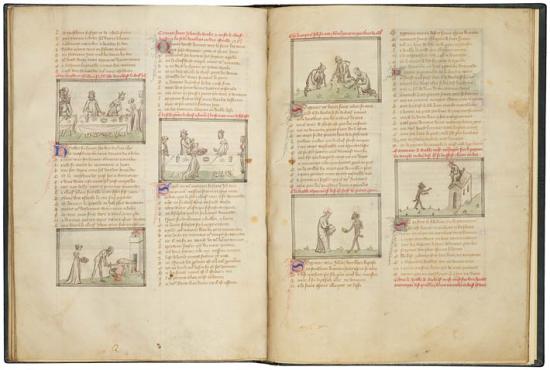
History of the Bible and of the Assumption of Our Lady, in French
Purchased by Pierpont Morgan, 1902
Salome, represented three times in the miniatures at the left, wears a cote hardy with a voluminous skirt but with contrastingly tight bodice, bosom, and sleeves. Except in the top scene, where she wears a coronet, the young girl's hair is loose and falls over her ears — a sign of her maidenhood. In the second miniature, her mother, Herodias, is similarly dressed, but in the first vignette she wears, befitting her queenly status, a surcot with extremely wide side openings. Her braided hair, along with the posts of her tressour, frames her face.
Wasp Waists and Stuffed Shirts
The second half of the fourteenth century was a bleak period in French history. The Black Plague, which first struck in 1348, was a recurring horror. As the Hundred Years' War dragged on, France suffered devastating defeats by the English. Following the Battle of Poitiers in 1356, King John II was captured and taken to London as a prisoner. Fashions changed little during this period.
Men's fashion was dominated by the pourpoint: a close-fitting doublet influenced by the military. With a short flaring skirt and a cinched waist, the pourpoint was padded at the chest and shoulders, giving its wearer a distinctive hourglass silhouette. Pouleines, long pointed shoes, and belts—slender, or the thick "Bohemian" girdle—worn low on the hips complimented the look.
The cote hardy—an outer garment for women—while retaining its voluminous skirt, got even tighter at the bodice, bosom, and sleeves. The resulting look paralleled that of men's fashion. Tippets, decorative strips of cloth hanging from the arms, remained popular. Both men and women continued to wear the chaperon (the hood with attached cape and tail).
Women Encounter Bad Advice and Irrationality
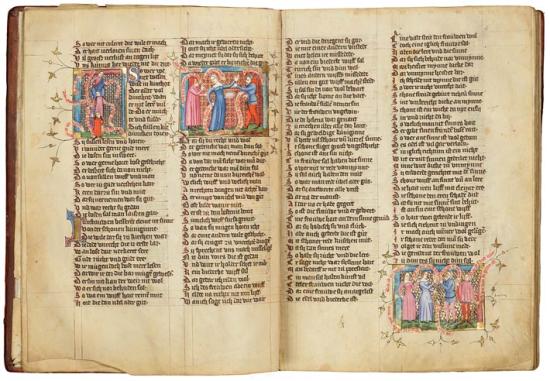
Der Wälsche Gast, in German
Illuminated by the Kuno von Falkenstein workshop
Gift of the Trustees of the William S. Glazier Collection, 1984
The women in this allegorical treatise wear cotes hardy similar to their French contemporaries (albeit on slightly plumper figures). Their loose skirts contrast with tight bodices, bosoms, and sleeves, the ends of which are slightly funnel shaped. In the second miniature at the left, the young male personification of Bad Advice wears a wasp-waisted, stuffed doublet. His pouleines (pointed shoes) are particularly elegant with open fretwork. In the miniature at the right the older male personification of Irrationality is similarly dressed. Behind him, the young male Seducer wears a dashing pink paltock (a loose jacket with sleeves) over his doublet.
Wasp Waists and Stuffed Shirts
The second half of the fourteenth century was a bleak period in French history. The Black Plague, which first struck in 1348, was a recurring horror. As the Hundred Years' War dragged on, France suffered devastating defeats by the English. Following the Battle of Poitiers in 1356, King John II was captured and taken to London as a prisoner. Fashions changed little during this period.
Men's fashion was dominated by the pourpoint: a close-fitting doublet influenced by the military. With a short flaring skirt and a cinched waist, the pourpoint was padded at the chest and shoulders, giving its wearer a distinctive hourglass silhouette. Pouleines, long pointed shoes, and belts—slender, or the thick "Bohemian" girdle—worn low on the hips complimented the look.
The cote hardy—an outer garment for women—while retaining its voluminous skirt, got even tighter at the bodice, bosom, and sleeves. The resulting look paralleled that of men's fashion. Tippets, decorative strips of cloth hanging from the arms, remained popular. Both men and women continued to wear the chaperon (the hood with attached cape and tail).
The Lover Encounters Wealth
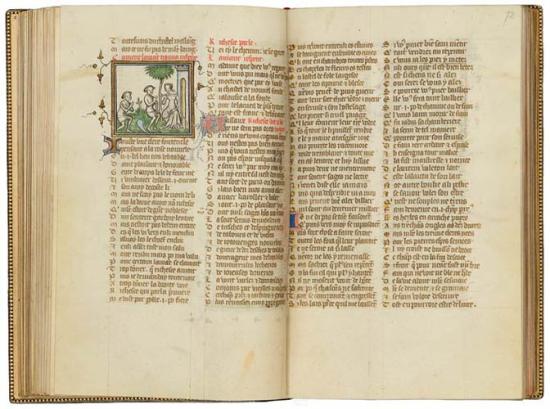
Romance of the Rose, in French
Illuminated by the Master of the Bible of Jean de Sy
Purchased by Pierpont Morgan, 1902
The Lover, the protagonist of the Roman de la rose, is shown twice in this miniature. He is depicted first approaching, then addressing the female personification of Wealth. He wears the hourglass-shaped doublet, with a low, narrow belt, and chaussembles (hose equipped with leather soles). His loose hair, parted in the middle, is that of a youth. Lady Wealth wears a cote hardy with tippets: slender strips of cloth attached to her upper arms (instead of the elbows, as was more customary). Her shoulders are draped with a chaperon, with its hood thrown back, and braids frame her face.
Wasp Waists and Stuffed Shirts
The second half of the fourteenth century was a bleak period in French history. The Black Plague, which first struck in 1348, was a recurring horror. As the Hundred Years' War dragged on, France suffered devastating defeats by the English. Following the Battle of Poitiers in 1356, King John II was captured and taken to London as a prisoner. Fashions changed little during this period.
Men's fashion was dominated by the pourpoint: a close-fitting doublet influenced by the military. With a short flaring skirt and a cinched waist, the pourpoint was padded at the chest and shoulders, giving its wearer a distinctive hourglass silhouette. Pouleines, long pointed shoes, and belts—slender, or the thick "Bohemian" girdle—worn low on the hips complimented the look.
The cote hardy—an outer garment for women—while retaining its voluminous skirt, got even tighter at the bodice, bosom, and sleeves. The resulting look paralleled that of men's fashion. Tippets, decorative strips of cloth hanging from the arms, remained popular. Both men and women continued to wear the chaperon (the hood with attached cape and tail).
Tormentors Are Always Well Dressed
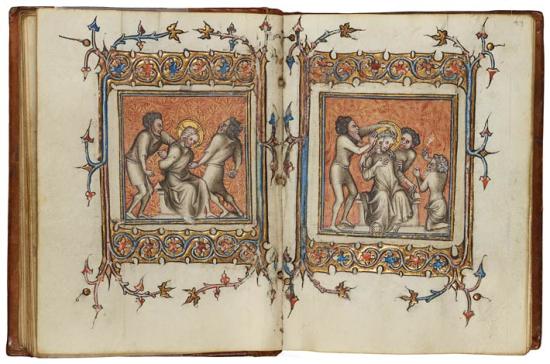
Book of Hours, in Latin and French
Illuminated by the Master of the Bible of Jean de Sy
Purchased by Pierpont Morgan, 1902
It was an unwritten rule for medieval artists that Christ was never fashionable. The opposite, however, applied to torturers and executioners, whose foppish obsession with elegant clothing was a reflection of their depravity. The two tormentors at the left wear the cote hardy with a loose bodice and a knee-length skirt. At the right, the kneeling man, who mockingly offers the Savior a reed as a scepter, also wears the cote hardy, the skirt of which is tucked into his belt. The bearded man, who rams the Crown of Thorns onto Christ's head, wears the shorter and tighter doublet.
Wasp Waists and Stuffed Shirts
The second half of the fourteenth century was a bleak period in French history. The Black Plague, which first struck in 1348, was a recurring horror. As the Hundred Years' War dragged on, France suffered devastating defeats by the English. Following the Battle of Poitiers in 1356, King John II was captured and taken to London as a prisoner. Fashions changed little during this period.
Men's fashion was dominated by the pourpoint: a close-fitting doublet influenced by the military. With a short flaring skirt and a cinched waist, the pourpoint was padded at the chest and shoulders, giving its wearer a distinctive hourglass silhouette. Pouleines, long pointed shoes, and belts—slender, or the thick "Bohemian" girdle—worn low on the hips complimented the look.
The cote hardy—an outer garment for women—while retaining its voluminous skirt, got even tighter at the bodice, bosom, and sleeves. The resulting look paralleled that of men's fashion. Tippets, decorative strips of cloth hanging from the arms, remained popular. Both men and women continued to wear the chaperon (the hood with attached cape and tail).
Fashion in a Missal
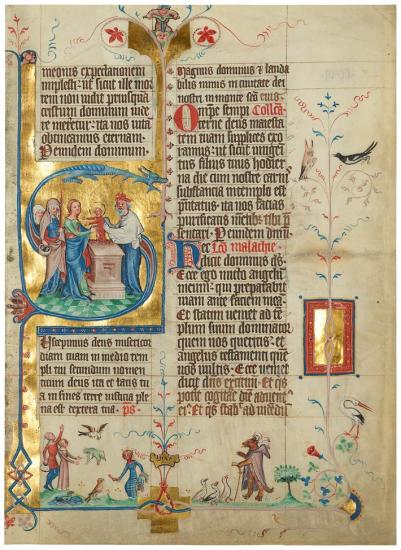
Single leaf from a Missal, in Latin
Illuminated by Meister Bertram von Minden
Purchased, 1958
Perhaps the doves carried by the Virgin Mary's attendant in the large scene inspired the illuminator to enliven the borders of this Missal leaf with avian themes. (The text is for the Feast of the Purification of the Virgin, celebrated on 2 February.) The young people hawking at the bottom left are fashionably dressed: the youth wears a red pourpoint with a dagged hem, a particularly tight chaperon, narrow belt, and open shoes. The women wear cotes hardy snug on the arms and upper body. The girl at the right has a tight red chaperon and, on top of that, a fanciful crown.
Wasp Waists and Stuffed Shirts
The second half of the fourteenth century was a bleak period in French history. The Black Plague, which first struck in 1348, was a recurring horror. As the Hundred Years' War dragged on, France suffered devastating defeats by the English. Following the Battle of Poitiers in 1356, King John II was captured and taken to London as a prisoner. Fashions changed little during this period.
Men's fashion was dominated by the pourpoint: a close-fitting doublet influenced by the military. With a short flaring skirt and a cinched waist, the pourpoint was padded at the chest and shoulders, giving its wearer a distinctive hourglass silhouette. Pouleines, long pointed shoes, and belts—slender, or the thick "Bohemian" girdle—worn low on the hips complimented the look.
The cote hardy—an outer garment for women—while retaining its voluminous skirt, got even tighter at the bodice, bosom, and sleeves. The resulting look paralleled that of men's fashion. Tippets, decorative strips of cloth hanging from the arms, remained popular. Both men and women continued to wear the chaperon (the hood with attached cape and tail).